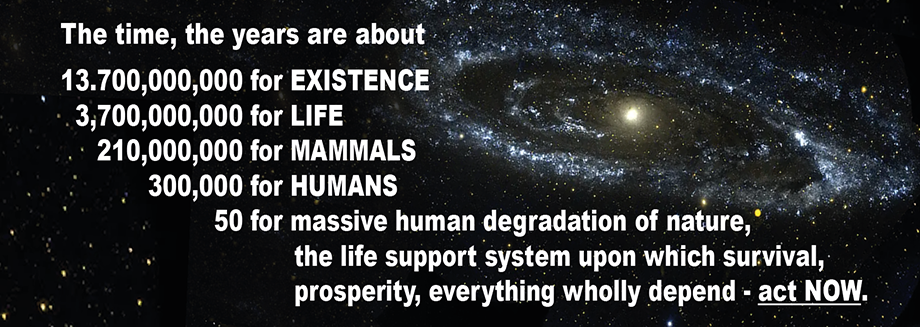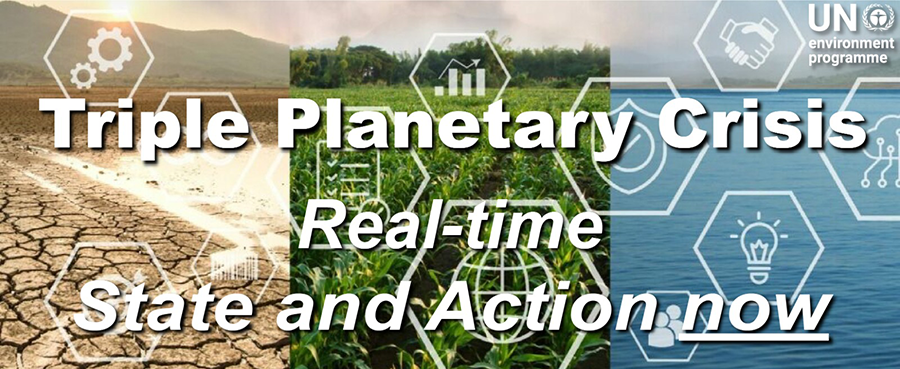






The cause of climate change is greenhouse gas emissions 1 2, the cause of nature destruction including 90% of biodiversity loss is natural resource consumption 3. Only, uniquely Existential Stocktake gives all 195 nation Parties’ emissions, consumptions, capabilities, responsibilities and adequate, responsible actions now to be within UN science limits to realize agreed existential objectives of the UN Climate and Biodiversity Treaties:
“limit global warming to well below 2ºC preferably 1.5ºC” 4 and “humans live in harmony with nature by 2050” 5.
Collapse. 50 years ago when science warnings began, global warming was a harmless 0.2ºC 6 and natural resource consumption a safe 0.4 “Earths” 7 8; today IPCC’s 83% (best) likelihood CO2 budget for 1.3ºC has been emitted 9 and consumption is 1.5 Earths 7 8. Current actions and policy trends lead to dangerous 1.5ºC emitted in just 3 years, catastrophic 2ºC in only 17 years, and by 2055 a ruinous 2.5ºC 10 and 3 Earths consumption 7 11.
These are relentless, unabated accelerating emission and consumption trends to massive global shortages of all essentials for life – food, water, energy, medicines, shelter – risking social-economic collapse with potentially hundreds of millions dead, billions forced from lands rendered uninhabitable, no one safe anywhere. 12 13
Figure 1: Human development, capability and responsibility 14

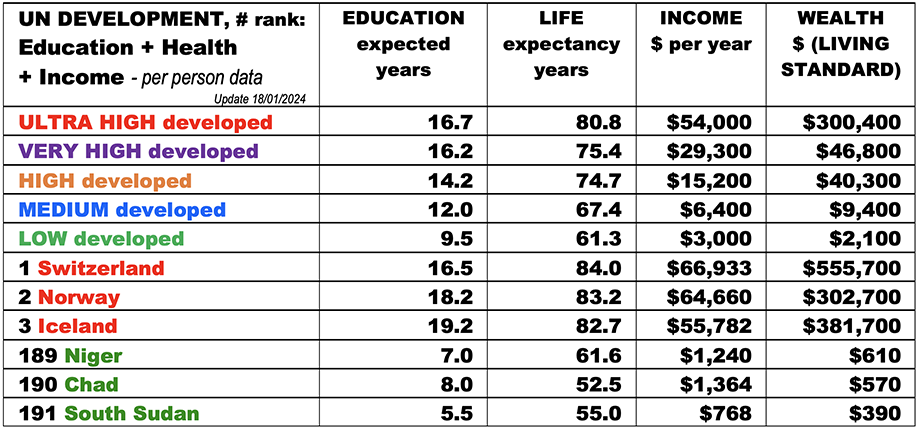
UN Ultra High developed nations (Figure 1, red in map) are the most educated, healthiest and wealthiest with the highest per capita emissions and consumption, they set the standards for all countries. Ultra High are just 12% of humanity with an astonishing 64% of global wealth causing 50% of climate changing emissions and 37% of nature destroying consumption 14.
In stunning contrast Low developed (green in map) are 15% of humanity with a nearly invisible 0.5% of wealth causing an insignificant 1% of emissions and 3% of consumption 14.
In the 50 years of science warnings Ultra High have increased consumption 14%, and have NOT meaningfully reduced emissions. 14

Ultra High developed set the standards, and the basic commitment of all other governments is that in order to achieve the desired living standards (wealth, health, education) they will raise their consumption and emissions per capita toward the planet-destroying standards set by the Ultra High – therefore Ultra High must lead and reduce to safe, sustainable limits, or no other nation will and social-economic collapse is ensured.
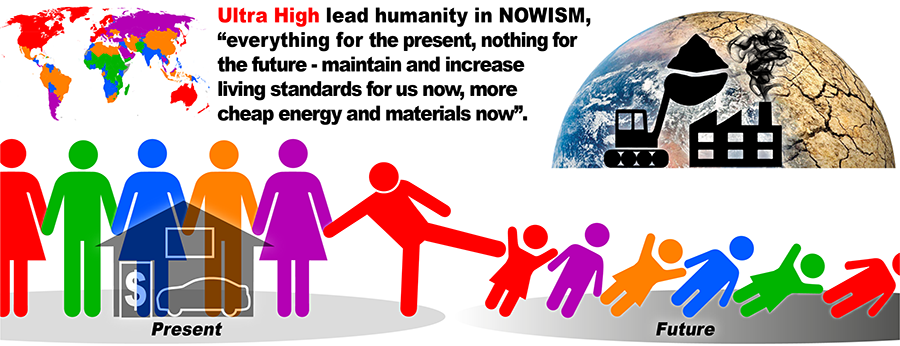
• Humanity’s existential problem is NOWISM
NOWISM. The 50 year and current underlying cause of trends risking collapse is that Ultra High nations lead humanity in
NOWISM, “everything for the present, nothing for the future, maintain and increase living standards for us now, more cheap energy, cheap materials NOW.
Ultra High goverments give the people what they think they want, everything spent on present needs, wants and desires, no spending on -, no investment in the future.
• Humanity’s existential solution is RESPONSIBILITY.
Existential Stocktake gives all nations’ per capita capabilities and responsibilities to be within UN science limits to realize the existential objectives of UN Climate & Biodiversity Treaties.
Since the first UN Environmental Conference in 1972, by international agreement actions by nation Parties are to be by “responsibility”, national “contribution to global environmental degradation” – as we teach our children “clean up the mess you make”. 15 16
1.5ºC / 2ºC emission limits, Intergovernmental Panel on Climate Change (IPCC).

To limit global warming to 2°C or 1.5°C, IPCC’s remaining 83% (best) likelihood CO2 budget is 96 and 29 tonnes per capita from 1 January 2021 onward, more than 3 years ago. 20
By current emission responsibility – not historic / cumulative – the average Ultra High developed nation (red in map) should reduce CO2 emissions -18% per year now for 2°C, and to be on-limit for 1.5ºC must remove from the atmosphere the equivalent of 9 tonnes CO2 per capita, increasing as hey further emit.
In sharp contrast, the average Low developed nation can increase +1.5% per year for 2°C and need to reduce only 1% per year for 1.5°C 20. Actions for all nations are HERE.
‘One Earth’ consumption limit. United Nations International Resource Panel (IRP).
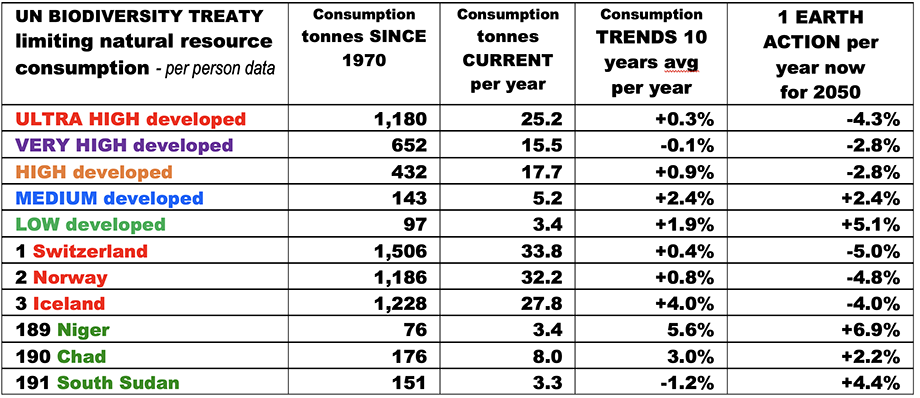
IRP’s sustainable consumption limit for “harmony with nature” is 7 tonnes natural resource extraction per year per capita by 2050, “1 Earth”, this includes all fossil fuels, minerals, metals and biomass 21.
To be on-limit, the average Ultra High developed nation should reduce current consumption -4.3% per year now; in contrast Low developed nations can increase up to +5.1% and still not exceed 7 tonnes / capita by 2050 21. Actions for all nations are HERE.
UN Biodiversity Treaty (CBD) Headline Target, “protect 30% of land and water by 2030” leaves extraction of natural resources unaddressed. Since 1970 “protected areas” increased more than 20 times as consumption escalated unabated and wildlife (biodiversity) populations plummeted 69%. 22 23 24
Figure 2: Total Primary Energy Supply per capita by fuel in tonnes of oil equivalent per year. 25

Energy supply per capita 25: Much is made of the importance of eliminating COAL, the most emitting fossil fuel. Extraordinarily Ultra High per capita energy supply of COAL alone equals or exceeds ALL energy used by Medium and Low. 25
Moreover, after 50 years of science warnings, Ultra High’s coal+oil+gas+bio emitting energy supply is still 85%; non-emitting nuclear is 10%, hydro 2%, wind-solar-geo-tidal-etc. is only 3%. 25
Figure 3: Compensation by Ultra High developed nations 26

Financial compensation. “African lands rendered uninhabitable”, “Pakistan one-third underwater”, “Hottest, day, month, year ever”… Compensation to “the least responsible, who suffer the most and are least capable to deal with it” by Ultra High, “the most responsible and capable”, for loss, damage and adaptation is necessary.
With an average annual income of $54,000 per year, Ultra High developed citizens spend about $3,000 per capita to purchase and benefit from energy causing climate changing emissions – and give a miniscule $176 per year, 50 cents per day in total foreign aid (grants and loans, Figure 4). 23
If all Ultra High nations match the “most generous” and give 0.9% of income, aid would increase 300% to about $500 billion per year. However, compensation can never keep up with rates of loss and damage 27 – relentlessly increasing emissions and consumption must be reduced adequately now to stop collapse and achieve humanity’s existential objectives.

Closed Mass Laws 28, resources are not imported, emissions are not exported.
As to the essentials of how national reductions are to be made, Earth is a closed mass system: sunlight (energy) comes in, but no meaningful mass (natural resources) is imported and atmospheric greenhouse gas emissions are held by gravity and not exported. Effective national emission and consumption action requires closed mass science laws: 28
- Change from quantity to quality by law.
- Extract / consume the fewest possible natural resources by law.
- Make only the very best, lasting, shared, repairable, cyclical products (which does not include fossil fuel combustion) by law. The reduction of products can be painless because after biological needs are met, happiness is first humans, activities and nature NOT products. 29
- Reduce human population – starting in Ultra High consuming / emitting nations.
Michael Wadleigh and Birgit van Munster, Only One Earth Science coordinators, +44 7538 416407, birgitvmunster@gmail.com
Notes, references,data sources
1 Eunice Foote (1856) Circumstances affecting the Heat of the Sun’s Rays. Read before the American Association.
2 Intergovernmental Panel on Climate Change (2023) 6th Assessment Synthesis Report, Climate Change 2023, Headline Statement A1
3 United Nations Environment International Resource Panel, Natural Resources for the Future We Want (2019). Key Fact: “90% of biodiversity loss is caused by extraction and processing (consumption) of natural resources”
4 United Nations Framework Convention on Climate Change (UNFCCC, 2015) Paris Agreement on Climate Change. Legally binding agreement adopted by 196 nations to hold the increase in the global average temperature to well below 2°C above pre-industrial levels and pursue efforts to limit the temperature increase to 1.5°C above pre-industrial levels.
5 United Nations Convention of Biological Diversity (CBD, 1992), an international legal instrument ratified by 196 nations. The Kunming-Montreal Global Biodiversity Framework (2022) sets out the plan to ensure that the Convention’s vision of living in harmony with nature by 2050 will be fulfilled.
6 GISTEMP Team, 2023: GISS Surface Temperature Analysis (GISTEMP), version 4. NASA Goddard Institute for Space Studies. Dataset accessed 2023-08-23 at https://data.giss.nasa.gov/gistemp
7 UNEP International Resource Panel (IRP), Managing and conserving the natural resource base for sustained economic and social development, 2014. “Limit natural resource consumption per capita to 7 (6-8) tonnes per year by 2050”, this is the equivalent of a total of 68 gigatonnes per year’ (expressed as “1 Earth” consumption).
8 United Nations Material Flow Database (2023 update): Extraction and consumption of natural resources increased from 30 billion tonnes in 1970 (» “0.4 Earth”) to 102 billion tonnes in 2023 and 104 billion tonnes in 2023 (104 Gt » “1.5 Earth”).
9 Intergovernmental Panel on Climate Change, AR6, WG1, Climate Change (2021) The Physical Science Basis. Table 5.8: Assessed remaining carbon budget.
– The remaining Carbon Budget (83% probability) to limit global warming to 1.3ºC (compared to 1850-1900) is 50 Gt CO2 by 1/1/2020, this was emitted by April 2021:
Friedlingstein et al (2022) Global Carbon Budget (2023v1), CO2 emissions: 2020: 39.3GtCO2, 2021: 41.1 GtCO2.
10 Intergovernmental Panel on Climate Change, AR6, WG1, Climate Change (2021) The Physical Science Basis. Table 5.8: Assessed remaining carbon budget.
- The remaining Carbon Budget (83% probability) to limit global warming to 1.5ºC / 2ºC / 2.4ºC (compared to 1850-1900) is 300 / 900 / 1,400 Gt CO2 by 1/1/2020. This does not include negative emissions or temperature overshoot. Of this 135 / 735 / 1,235 Gt CO2 remains by 1/1/2023:
- Friedlingstein et al (2023) Global Carbon Budget (2023v1), CO2 emissions: 2020: 39.3, GtCO2, 2021: 41.1 GtCO2, 2022: 41.5 CO2 Gt, 2023 estimate 41.8 GtCO2
- United Nations Framework Convention on Climate Change, Synthesis Report (2022). “NDCs cumulative CO2 emissions in 2020-2030 are estimated to be around 430 GtCO2”. This is 43% over the limit for 1.5ºC (83% likelihood), which will be exhausted in 2027 if NDCs are achieved. However, there is an ‘implementation gap’ and projected emissions under current policies are even higher (IPCC-AR6-SYR-A4.4).
- Climate Action Tracker, Global Emissions Timeseries November 2023 Update. In the “actions and current policies” scenarios, cumulative global CO2 emissions (72%-77% of GHG) from 1/1/2020 exceed 300 Gt CO2 in 2027, 900 Gt CO2 in 2041 and 1,550 GtCO2 in 2055.
11 Krausmann F, Lauk C, Haas W, Wiedenhofer D. Data file Global material extraction, in-use stocks and outflows of wastes and emissions 1900-2015. From resource extraction to outflows of wastes and emissions: The socioeconomic metabolism of the global economy, 1900-2015. Global Environmental Change (2018); 52: 131–140, “estimate what a global convergence of metabolic patterns at the current level in industrialized countries paired with a continuation of past efficiency gains might imply for global material demand. We find that .. until 2050 average global metabolic rates double to 22 t/cap/yr and material extraction increases to around 218 Gt/yr.” (210 Gt » “3 Earths”)
12 United Nations Secretary General’s remarks to High Level Opening COP 27 (2022) “We are in the fight of our lives. And we are losing. Greenhouse gas emissions keep growing. Global temperatures keep rising. And our planet is fast approaching tipping points that will make climate chaos irreversible. We are on a highway to climate hell with our foot still on the accelerator. .. Humanity has a choice: cooperate or perish. It is either a Climate Solidarity Pact – or a Collective Suicide Pact.”
13 Kemp L. et al. Climate Endgame: exploring catastrophic climate change scenarios. Proceedings National Academy of Sciences (2022) Vol. 119 No. 34.
14 Data Sources:
- Human Development: United Nations Development Programme, Human Development Index, 2022
- Ultra High Developed (red on map): HDI > 0.900,
- Very High Developed (purple on map): HDI 0.800-0.900,
- High Developed (orange on map): HDI 0.700-0.800,
- Medium Developed (blue on map): HDI 0.550 – 0.700,
- Low Developed (green on map) <0.550
- Population: United Nations World Population Prospects, 2022 revision, medium estimate
- Credit Suisse Research Institute, Global Wealth Databook, 2023
- – Global Carbon Budget 2023v1.0, National Fossil Carbon Emissions, Territorial emissions 1850-2022
- – United Nations Environment Programme, International Resource Panel (IRP), Global Material Flows Database, 2023, Material footprint
15 United Nations (1972) Declaration on the Human Environment, principle 21.
United Nations (1992) Rio Declaration on Environment and Development, principle 7.
16 United Nations (1992) Framework Convention on Climate Change, principle 1.
17 Data Sources:
- Human Development: United Nations Development Programme, Human Development Index, 2022
- Population: United Nations World Population Prospects, 2022 revision, medium estimate
- Credit Suisse Research Institute, Global Wealth Databook, 2023
- Global Carbon Budget 2023v1.0, National Fossil Carbon Emissions, Territorial emissions 1850-2022
- – United Nations Environment Programme, International Resource Panel (IRP), Global Material Flows Database, 2023, Material footprint
18 “Halve global CO2 by 2030, net zero by 2050 for 1.5ºC“ is misleading.
- It omits that this is for just a > 50% chance to limit temperature to 1.5ºC (AR6 SYR SPM B6)
- Includes temporary temperature overshoot risking irreversible tipping points (AR6 SYR SPM B6, B7)
- Requires massive amounts of speculative negative emissions at a scale scientists warn may not be technically, physically and socially feasible (AR6 SYR SPM B7, longer report 3.3.
- World Resource Institute, 2023, 10 big findings from the 2023 IPCC climate Report: “The amount of carbon removal .. ranging from between 5 GtCO2 to 16 GtCO2 per year needed by mid-century”. In comparison the total global terrestrial carbon sink is about 11 GtCO2 per year (2012-2021 average per year, Global Carbon Project 2023.)
- It omits that most 1.5ºC pathways rely on substantial reductions in consumption and population. (IAMC 1.5°C Scenario Explorer and Data hosted by IIASA. Integrated Assessment Modelling Consortium & International Institute for Applied Systems Analysis, (2019)).
- It further omits that in reality global GHG emissions are increasing, not decreasing, with 2021 emissions 3.8% above 2020 (http://doi.org/10.1038/s41597-023-02041-1), 2022 emissions 1% above 2021 and 2023 estimated to be 1% above 2022.
- It omits that “halve CO2 by 2030” requires an average reduction of about 7.8% each year between 2023 and 2030. This omission allows political leaders to focus on targets in the future, not on the deep reductions required now.
- Last but not least, it omits that wealthy Ultra High Developed countries with current per capita GHG emissions far above the global average must reduce much faster.
- United Nations Secretary General’s message at launch AR6-SYR (2023): “It starts with parties immediately hitting the fast-forward button on their net zero deadlines to get to global net zero by 2050 – in line with the principle of common but differentiated responsibilities and respective capabilities, in light of different national circumstances. Specifically, leaders of developed countries must commit to reaching net zero as close as possible to 2040, the limit they should all aim to respect.”)
19 Data sources:
- Human Development: United Nations Development Programme, Human Development Index, 2022
- Population: United Nations World Population Prospects, 2022 revision, medium estimate
- Global Carbon Budget 2023v1.0, National Fossil Carbon Emissions, Consumption emissions (CO2 emissions from the consumption of goods and services). Trend: average annual change 1990-2019.
- United Nations Environment Programme, International Resource Panel (IRP), Global Material Flows Database, 2023, Material footprint (UN definition “Material footprint”: the total amount of raw materials extracted to meet final consumption demands.) Trend: average annual change 1990-2019.
20 Intergovernmental Panel on Climate Change, AR6, WG1, Climate Change (2021) The Physical Science Basis. Table 5.8: Assessed remaining carbon budget.
- The remaining Carbon Budget (83% probability) to limit global warming to 1.5ºC / 2ºC (compared to 1850-1900) is 300 / 900 GtCO2 by 1/1/2020, or 260 / 960 GtCO2 by 1/1/2021.
- Land-use emissions are about 12% of total CO2 emissions and therefore 88% of the budget is allocated to fossil fuels and industry, 228 / 756 GtCO2 for 1.5ºC / 2ºC.
- Divided equally among humanity the per capita limit by 1/1/2021 is 29 tonnes CO2 for 1.5ºC and 96 tonnes CO2 for 2ºC.
- With 960 million people, Ultra High developed nations’ CO2 budget was 27 / 91 GtCO2 for 1.5ºC / 2ºC by 1.1.2021. As of 1.1.2024 UHD have exceeded their 1.5ºC budget by 8 GtCO2 and must now remove this plus all they emit. Only 55 GtCO2 remained of their 2ºC budget, and UHD CO2 emissions must be reduced 18% per year to avoid exceeding their 2ºC budget.
- With 1.2 billion people Low developed nations’ carbon budget was 34 / 114 GtCO2 for 1.5ºC / 2ºC by 1.1.2021. As of 1.1.2024, 33 / 112 GtCO2 remained, and LD CO2 emissions be reduced 1% / can increase 1.5% per year to avoid exceeding their 1.5ºC / 2ºC budget.
21 UNEP International Resource Panel (IRP), Managing and conserving the natural resource base for sustained economic and social development, 2014. To live in harmony with nature “limit natural resource consumption per capita to 7 (6-8) tonnes per year by 2050.’
United Nations Environment Programme, International Resource Panel (IRP), Global Material Flows Database, 2023, Material footprint:
- Ultra High developed nations average resource consumption is 25 tonnes per capita per year, twice the global average. To achieve 7 tonnes per capita by 2050, a reduction of 4% per year is required.
- Low developed nations average resource consumption is 3 tonnes per capita per year, about one quarter of the global average. To achieve 7 tonnes per capita by 2050, Low develop nations can increase consumption 5% per year.
22 UN Environment Programme World Conservation Monitoring Centre (UNEP-WCMC), World Database on Protected Areas (2022).
Protected areas (OECM total) including marine, freshwater and terrestrial areas were 2.8 million km2 (0.55% of global surface) in 1970, increasing to 60.8 million km2 (12.3%) in 2022.
23 United Nations Material Flow Database (2023 update): Extraction and consumption of natural resources increased from 30 billion tonnes in 1970 to 102 billion tonnes in 2023 and 104 billion tonnes in 2024.
24 WWF Living Planet Report 2020 – Bending the curve of biodiversity loss. “Wildlife have endured an average 69 per cent drop in monitored populations of mammals, birds, amphibians, reptiles and fish since 1970”
Intergovernmental Science Policy Platform on Ecosystem Services 2019 Global assessment report, finds that around 1 million animal and plant species are now threatened with extinction, many within decades, more than ever before in human history.
25 Data Sources:
- TPES: International Energy Agency, Total primary energy supply by fuel (2020);
- Population: United Nations World Population Prospects (2022 revision) medium estimate,
- Human Development: United Nations Development Programme, Human Development Index, 2022.
26 Data sources
- Aid received / donated: The World Bank, Databank World development indicators, Net official development assistance and official aid received / given. Data are in constant 2020 U.S. dollars.
- Human Development: United Nations Development Programme, Human Development Index, 2022
- Gross national Income: United Nations Development Programme, Human Development Index, 2022
- Population: United Nations World Population Prospects (2022 revision) medium estimate.
27 Mann M. (2023) Our Fragile Moment, ‘there is no amount of adaptation that will prepare us for what is to come if we fail to deal with the underlying problem, which is the warming of the planet from the burning of fossil fuels and the increase of carbon emissions that is resulting from that.”
28 Closed mass laws are an original concept based on physics fundamentals – “as simple as possible, but not too simple” (Albert Einstein).
29 Kasser T. The high price of materialism. MIT Pres
